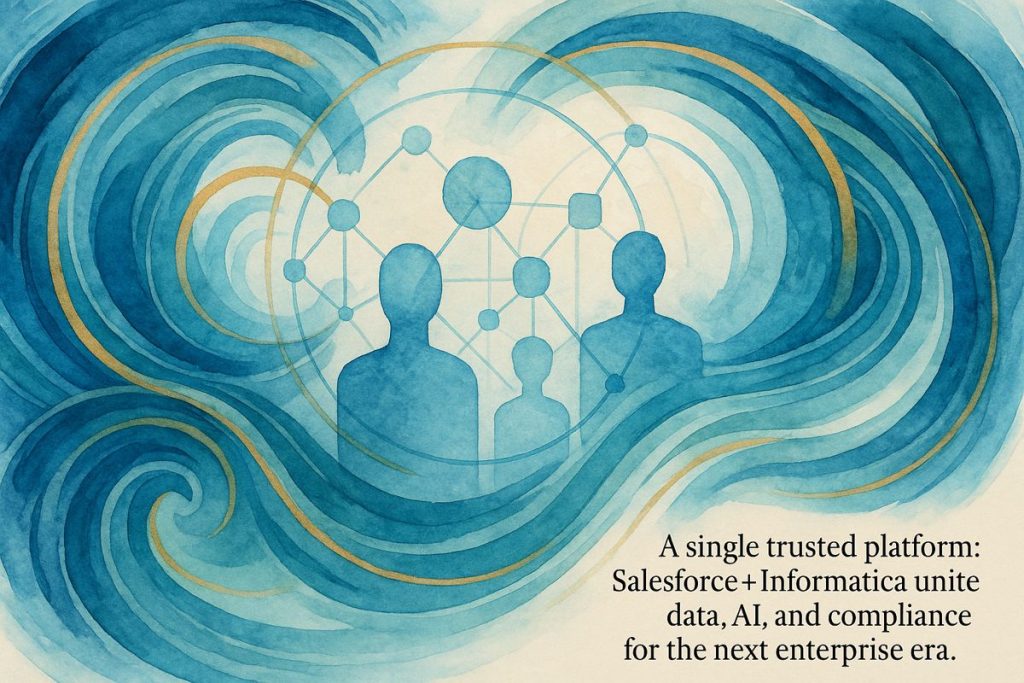Salesforce just bought Informatica for $8 billion in cash, hoping to become the top player in managing and connecting big business data. This deal is all about making Salesforce’s tools work better together and helping companies in strict industries keep their data safe and organized. Informatica’s special cloud tools can help track, control, and protect data, which is super important for companies like drug makers. Some people worry there’s overlap with MuleSoft, another Salesforce company, and aren’t sure how everything will fit together. Still, Salesforce wants to use Informatica’s power to lead in data and trusted AI for big businesses.
Why did Salesforce acquire Informatica for $8 billion?
Salesforce acquired Informatica for $8 billion to strengthen its data integration, governance, and master data management capabilities, aiming to unify its CRM, MuleSoft, and Tableau offerings. This move targets regulated industries and supports Salesforce’s strategy to lead in enterprise data management and trustworthy AI solutions.
The Big Splash: Coffee, Cash, and Convergence
When Salesforce announced it would acquire Informatica for a neat $8 billion in cash, my first thought was: is this just another mega-merger, or are we witnessing a tectonic tremor beneath enterprise data’s palimpsest? I nearly dropped my morning espresso—bitterness, a jolt of excitement, and that familiar whiff of skepticism all mingled together. $8 billion is hardly spare change, even for Marc Benioff and company. In fact, it’s Salesforce’s biggest acquisition since their $27.7 billion Slack buy in 2021 (Salesforce press release).
But unlike Slack, a chat tool with a cultish following, Informatica brings something more quietly potent to the table: the guts and plumbing of enterprise data integration. If you’ve ever worked in a regulated industry—think pharmaceutical titans or the labyrinthine world of life sciences—you know that data isn’t just a byproduct; it’s the bloodstream, and one bad transfusion can send regulatory antibodies into a frenzy.
The deal itself? Informatica’s Class A and Class B-1 shares get valued at $25 each, with a closing date penciled in for early fiscal 2027 (pending, of course, the ever-cryptic regulatory gods). Informatica touts over 5,000 global customers and was valued around $7.1 billion before Salesforce swooped in (TechCrunch). That’s no vaporware.
Stitching Together the Data Patchwork
So, why do this—why now? Salesforce wants to unify the data fabric that connects its CRM, MuleSoft (remember their $6.5 billion purchase back in 2018?), and Tableau portfolios. Informatica’s muscle in data integration, data governance, and what insiders call master data management (MDM) is meant to be the missing thread. If you’re envisioning agentic AI—think hyperspectral, self-learning models that operate a tad like the nervous system of an octopus, simultaneously processing and acting across domains—Salesforce wants that architecture to be theirs and theirs only (CIO Dive).
The crown jewel here is Informatica’s Intelligent Data Management Cloud (IDMC). Picture it as a control panel that lets enterprises herd, catalog, and govern their data across multi-cloud and hybrid environments—a feat akin to conducting a symphony in a thunderstorm. For compliance-obsessed sectors, this is less about bells and whistles and more about survival. Salesforce’s intent: stake their claim in a $150+ billion enterprise data market (Grand View Research 6 Enterprise Data Management Market Size Report, 2030) and put enterprise-grade, “trustworthy” AI front and center (BARC).
At this point, I had to stop and ask myself: Haven’t we heard this “single source of truth” mantra before? I once tried to unify three CRMs during a (mercifully brief) stint in pharma IT. The result: Kafkaesque meetings, and an email thread that still haunts me. Lesson learned: integrations are easy to promise, devilishly hard to execute.
The Elephant in the Server Room: Informatica vs. MuleSoft
Let’s not sugarcoat it—there’s overlap here. Informatica and MuleSoft both offer enterprise-grade data integration, and I’d wager more than a few MuleSoft partners are popping antacids at the news. Informatica stands apart on data cataloging, governance, and MDM, but you’d be forgiven for wondering whether this is synergy or redundancy (CX Today). Tom Morgan, among other analysts, has flagged the potential for confusion and a bumpy ride for existing MuleSoft customers.
Industry pals at Customertimes and similar outfits are eyeing the coming integration saga with a mix of hope and unease. I remember a partner call where someone joked, “Will MuleSoft become the Betamax of Salesforce?” Ouch. Yet, there’s wisdom in that cynicism. For Salesforce, managing ecosystem trust during these tectonic shifts is every bit as critical as the underlying tech (TopMostAds).
What’s that noise? The distant hum of partner forums lighting up. Some excitement, some dread—mostly, a thirst for clarity on roadmaps and support. Uncertainty always has a metallic taste, doesn’t it?
Regulated Industries: Where the Stakes Smell Like Formaldehyde
Here’s where the narrative gets interesting—or at least, where the stakes become existential. In life sciences, pharmaceuticals, or any sector where one compliance misstep can incite a regulatory maelstrom, Informatica’s strengths loom large. The ability to track data lineage, lock down governance, and guarantee auditability is as critical as the enzymes in a metabolic pathway (AIM Research).
Let’s get specific. Informatica’s IDMC lets drug companies document every data hop from molecule discovery to clinical trials (Takeda modernizes data to the cloud with Informatica (Official Informatica Case Study)). This isn’t just about pleasing auditors; it
